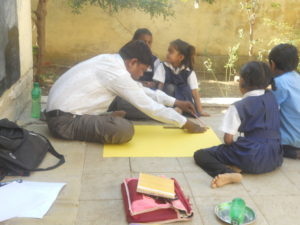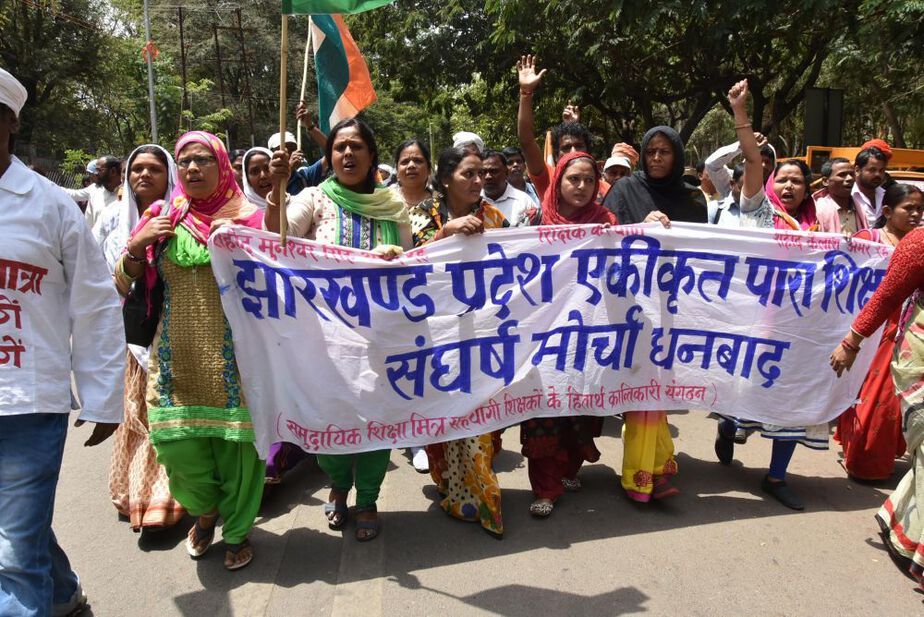Co-authored by Chetna Kumar and Avantika Bunga
On 17th January 2019, more than 45,000 ‘para-teachers’ in Jharkhand called off their 63-day hunger strike. As per their demands under the campaign “Same Work, Same Pay”, the state government has committed to the regularization of their services and an increase in their remuneration. The strike has reportedly affected over one lakh students across 35,000 schools, which had to be shut for two months during the strike, thus bringing into focus the immense importance of these contract teachers in India’s state schooling systems.
Who are Para-Teachers?
Para-teachers, also known as contract teachers, are typically primary or upper primary level educators appointed on a contractual basis. Although the exact definition of para-teachers differs from state to state, these teachers are generally hired from within local communities and have qualifications and salaries varying significantly from those of the regular cadre of teachers.

The concept of para-teachers crosses international borders. The underlying philosophy behind the appointment of para-teachers in different countries has been that a local person appointed as a teacher is better able to relate with students and can be held accountable to the local community. The practice was further popularized after the 1996 report by the International Commission on Education for the Twenty-First Century recommended using “members of the community as auxiliary teachers or para-professionals within the school system as one form of community participation”.
However, there is a clear distinction between the concept of para-teachers abroad and that prevalent in India. While para-teachers are meant to assist regular teachers in developed nations, they are often used as ‘proxies’ to replace regular teachers in Indian schools. This fundamental difference in the scope and role of para-teachers in our schooling system has led to the inefficacy of what was originally a sound approach to education policy.
Para-teachers in India: Origin and Current Status
In an interview with The Bastion, Anurag Shukla, a research scholar at IIM Ahmedabad, explains how the evolution of para-teaching in India was set against the backdrop of the unique politico-economic climate of the 1980s. With a burgeoning population, a severe fiscal deficit and mounting pressure on the country’s educational infrastructure, the need to explore alternative cost-effective pathways to impart primary education on a large scale became apparent. It was after the establishment of the District Primary Education Programme (DPEP) in 1994 that the utility of para-teachers in achieving the looming target of universal primary education became widely acknowledged and accepted.
Over the years, para-teachers have become an indispensable part of the state schooling machinery in India, especially in states like Jharkhand, Madhya Pradesh, Uttar Pradesh and Bihar. According to a recent government report, 44% of Jharkhand’s school teachers are working on a contractual basis. Levels of training and appointment duration vary across states. Existing research suggests that while some para-teachers have qualifications comparable to those of regular teachers and may also eventually get their tenure extended, they are almost always paid only a fraction of what their regular counterparts receive. As highlighted during the recent strikes, para-teachers in Jharkhand earn approximately Rs. 8,000 per month, while regular teachers draw a salary in the range of Rs. 40,000.
#Secular India*#Brand West Bengal*
CPIM’s Central Committee Member & Left Front’s WB State Legislative Party Leader Dr.Sujan Chakraborty writes a letter to CM demanding immediate pay-hike for the Para Teachers of the Govt-aided Primary & Secondary/Higher Secondary Schools. pic.twitter.com/YWvHFtpR02— SUNDAR DUTTA (@SUNDARmyth) June 28, 2018
In 2018, the West Bengal government increased the salaries for para-teachers by Rs 4000 (to Rs. 10,000) at the primary level and Rs 4500 (to Rs. 13,000) in the higher secondary level.
Teacher Effectiveness and Learning Outcomes
India is currently experiencing an emergency in primary education. Although indicators like sex-disaggregated enrolment rates have shown an upward trend in recent years, there is stagnation or even a decline in indicators of learning outcomes. According to the findings of the latest Annual Status of Education Report (ASER), 57% students in the 14-18 age group could not perform simple division and 25% of them could not read basic text in their own language.
In such a dismal scenario, the importance of effective teaching has been reinforced further in education policy discourse. Recent research in India and globally has shown that teacher effectiveness is “the most important school-based predictor of student learning and that several consecutive years of outstanding teaching can offset the learning deficits of disadvantaged students.”
There are several factors that incentivize effective teaching. A World Bank study on teacher management policy identifies a number of such factors, including standardized guidelines for recruitment, provisioning of adequate support systems (on-the-job training, mentorship and state-sponsored induction programs), establishing performance-based pay scales, and opportunities for professional growth. What is immediately apparent from the findings of this study is that many of the factors that prompt effective teaching, and further translate into better learning, are missing in the case of para-teachers.
As Mr Shukla observes, “contract teachers are never invited for teachers’ training programmes and are often made a scapegoat when it comes to any non-academic work at the school level. The contractual nature of their job limits their agency and negotiating power against various kinds of discrimination. Several studies have documented the burnout among the para-teachers and have decried the pitiable working conditions under which these para-teachers often work.”
The Way Forward
Evidently, the contract-teaching phenomenon in India has led to a fundamental breakdown of the incentive-based approach to teacher effectiveness. What our education policy needs today is to find ways to leverage the predominance of para-teachers in Indian schools favourably to address the ever-widening learning deficit.
Under the framework of the RTE Act, any individual who wants to be a primary teacher in government schools has to pass the Teacher Eligibility Test (TET) mandatorily. Para-teachers hoping to get their services regularized are also required to pass this test. In this case, as Mr Shukla points out, “any policy intervention which is devised around the para-teachers would be considered invalid and illegal”.
However, the need of the hour is to develop a more accommodative legal and infrastructural framework to absorb the large numbers of contract teachers into the national teaching workforce and to secure the prerequisites that incentivize and enable them to perform better. Providing uniform training and certification to para-teachers, revising their remuneration structures and giving them more professional agency must be a top priority.
Featured image courtesy TSD







[…] teachers—think para teachers, art teachers, computer teachers, or sports teachers—who are indispensable elements of India’s fragmented teaching system, especially in rural areas. Overall, about 13% of India’s teachers are contractual or casual […]
[…] teachers—think para teachers, art teachers, computer teachers, or sports teachers—who are indispensable elements of India’s fragmented teaching system, especially in rural areas. Overall, about 13% of India’s teachers are contractual or casual […]